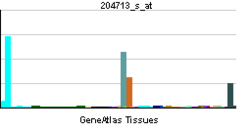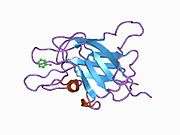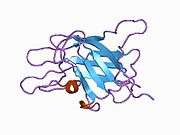Factor V
| Coagulation factor V (proaccelerin, labile factor) | |||||||||||||
|---|---|---|---|---|---|---|---|---|---|---|---|---|---|
|
PDB rendering based on 1czs. | |||||||||||||
| |||||||||||||
| Identifiers | |||||||||||||
| Symbols | F5 ; FVL; PCCF; RPRGL1; THPH2 | ||||||||||||
| External IDs | OMIM: 612309 MGI: 88382 HomoloGene: 104 ChEMBL: 3618 GeneCards: F5 Gene | ||||||||||||
| |||||||||||||
| RNA expression pattern | |||||||||||||
 | |||||||||||||
 | |||||||||||||
| More reference expression data | |||||||||||||
| Orthologs | |||||||||||||
| Species | Human | Mouse | |||||||||||
| Entrez | 2153 | 14067 | |||||||||||
| Ensembl | ENSG00000198734 | ENSMUSG00000026579 | |||||||||||
| UniProt | P12259 | O88783 | |||||||||||
| RefSeq (mRNA) | NM_000130 | NM_007976 | |||||||||||
| RefSeq (protein) | NP_000121 | NP_032002 | |||||||||||
| Location (UCSC) |
Chr 1: 169.51 – 169.59 Mb |
Chr 1: 164.15 – 164.22 Mb | |||||||||||
| PubMed search | |||||||||||||
Factor V (pronounced factor five) is a protein of the coagulation system, rarely referred to as proaccelerin or labile factor. In contrast to most other coagulation factors, it is not enzymatically active but functions as a cofactor. Deficiency leads to predisposition for hemorrhage, while some mutations (most notably factor V Leiden) predispose for thrombosis.
Genetics
The gene for factor V is located on the first chromosome (1q23). It is genomically related to the family of multicopper oxidases, and is homologous to coagulation factor VIII. The gene spans 70 kb, consists of 25 exons, and the resulting protein has a relative molecular mass of approximately 330kDa.
Physiology
Factor V synthesis occurs in the liver, principally. The molecule circulates in plasma as a single-chain molecule with a plasma half-life of 12–36 hours.[1]
Factor V is able to bind to activated platelets and is activated by thrombin. On activation, factor V is spliced in two chains (heavy and light chain with molecular masses of 110000 and 73000, respectively) which are noncovalently bound to each other by calcium. The thereby activated factor V (now called FVa) is a cofactor of the prothrombinase complex: The activated factor X (FXa) enzyme requires calcium and activated factor V to convert prothrombin to thrombin on the cell surface membrane.
Factor Va is degraded by activated protein C, one of the principal physiological inhibitors of coagulation. In the presence of thrombomodulin, thrombin acts to decrease clotting by activating Protein C; therefore, the concentration and action of protein C are important determinants in the negative feedback loop through which thrombin limits its own activation.
Role in disease
Various hereditary disorders of factor V are known. Deficiency is associated with a rare mild form of hemophilia (termed parahemophilia or Owren parahemophilia), the incidence of which is about 1:1,000,000. It inherits in an autosomal recessive fashion.
Other mutations of factor V are associated with venous thrombosis. They are the most common hereditary causes for thrombophilia (a tendency to form blood clots). The most common one of these, factor V Leiden, is due to the replacement of an arginine residue with glutamine at amino acid position 506 (R506Q). All prothrombotic factor V mutations (factor V Leiden, factor V Cambridge, factor V Hong Kong) make it resistant to cleavage by activated protein C ("APC resistance"). It therefore remains active and increases the rate of thrombin generation.
| Condition | Prothrombin time | Partial thromboplastin time | Bleeding time | Platelet count |
|---|---|---|---|---|
| Vitamin K deficiency or warfarin | Prolonged | Normal or mildly prolonged | Unaffected | Unaffected |
| Disseminated intravascular coagulation | Prolonged | Prolonged | Prolonged | Decreased |
| Von Willebrand disease | Unaffected | Prolonged or unaffected | Prolonged | Unaffected |
| Hemophilia | Unaffected | Prolonged | Unaffected | Unaffected |
| Aspirin | Unaffected | Unaffected | Prolonged | Unaffected |
| Thrombocytopenia | Unaffected | Unaffected | Prolonged | Decreased |
| Liver failure, early | Prolonged | Unaffected | Unaffected | Unaffected |
| Liver failure, end-stage | Prolonged | Prolonged | Prolonged | Decreased |
| Uremia | Unaffected | Unaffected | Prolonged | Unaffected |
| Congenital afibrinogenemia | Prolonged | Prolonged | Prolonged | Unaffected |
| Factor V deficiency | Prolonged | Prolonged | Unaffected | Unaffected |
| Factor X deficiency as seen in amyloid purpura | Prolonged | Prolonged | Unaffected | Unaffected |
| Glanzmann's thrombasthenia | Unaffected | Unaffected | Prolonged | Unaffected |
| Bernard-Soulier syndrome | Unaffected | Unaffected | Prolonged | Decreased or unaffected |
| Factor XII deficiency | Unaffected | Prolonged | Unaffected | Unaffected |
| C1INH deficiency | Unaffected | Shortened | Unaffected | Unaffected |
History
Until the discovery of factor V, coagulation was regarded as a product of four factors: calcium (IV) and thrombokinase (III) together acting on prothrombin (II) to produce fibrinogen (I); this model had been outlined by Paul Morawitz in 1905.[2]
The suggestion that an additional factor might exist was made by Dr Paul Owren (1905–1990), a Norwegian physician, during his investigations into the bleeding tendency of a lady called Mary (1914–2002). She had suffered from nosebleeds and menorrhagia (excessive menstrual blood loss) for most her life, and was found to have a prolonged prothrombin time, suggesting either vitamin K deficiency or chronic liver disease leading to prothrombin deficiency. However, neither were the case, and Owren demonstrated this by correcting the abnormality with plasma from which prothrombin had been removed. Using Mary's serum as index, he found that the "missing" factor, which he labeled V (I-IV having been used in Morawitz' model), had particular characteristics. Most investigations were performed during the Second World War, and while Owren published his results in Norway in 1944, he could not publish them internationally until the war was over. They appeared finally in The Lancet in 1947.[2][3]
The possibility of an extra coagulation factor was initially resisted on methodological grounds by Drs Armand Quick and Walter Seegers, both world authorities in coagulation. Confirmatory studies from other groups led to their final approval several years later.[2]
Owren initially felt that factor V (labile factor or proaccelerin) activated another factor, which he named VI. VI was the factor that accelerated the conversion from prothrombin to thrombin. It was later discovered that factor V was "converted" (activated) by thrombin itself, and later still that factor VI was simply the activated form of factor V.[2]
The complete amino acid sequence of the protein was published in 1987.[4] In 1994 factor V Leiden, resistant to inactivation by protein C, was described; this abnormality is the most common genetic cause for thrombosis.[5]
Interactions
Factor V has been shown to interact with Protein S.[6][7]
References
- ↑ Huang JN, Koerper MA (Nov 2008). "Factor V deficiency: a concise review". Haemophilia 14 (6): 1164–1169. doi:10.1111/j.1365-2516.2008.01785.x. PMID 19141156.
- 1 2 3 4 Stormorken H (Feb 2003). "The discovery of factor V: a tricky clotting factor". Journal of Thrombosis and Haemostasis 1 (2): 206–13. doi:10.1046/j.1538-7836.2003.00043.x. PMID 12871488.
- ↑ Owren PA (Apr 1947). "Parahaemophilia; haemorrhagic diathesis due to absence of a previously unknown clotting factor". Lancet 1 (6449): 446–51. doi:10.1016/S0140-6736(47)91941-7. PMID 20293060.
- ↑ Jenny RJ, Pittman DD, Toole JJ, Kriz RW, Aldape RA, Hewick RM, Kaufman RJ, Mann KG (Jul 1987). "Complete cDNA and derived amino acid sequence of human factor V". Proceedings of the National Academy of Sciences of the United States of America 84 (14): 4846–50. doi:10.1073/pnas.84.14.4846. PMC 305202. PMID 3110773.
- ↑ Bertina RM, Koeleman BP, Koster T, Rosendaal FR, Dirven RJ, de Ronde H, van der Velden PA, Reitsma PH (May 1994). "Mutation in blood coagulation factor V associated with resistance to activated protein C". Nature 369 (6475): 64–7. doi:10.1038/369064a0. PMID 8164741.
- ↑ Heeb MJ, Kojima Y, Rosing J, Tans G, Griffin JH (Dec 1999). "C-terminal residues 621-635 of protein S are essential for binding to factor Va". The Journal of Biological Chemistry 274 (51): 36187–92. doi:10.1074/jbc.274.51.36187. PMID 10593904.
- ↑ Heeb MJ, Mesters RM, Tans G, Rosing J, Griffin JH (Feb 1993). "Binding of protein S to factor Va associated with inhibition of prothrombinase that is independent of activated protein C". The Journal of Biological Chemistry 268 (4): 2872–7. PMID 8428962.
Further reading
- Nicolaes GA, Dahlbäck B (Apr 2002). "Factor V and thrombotic disease: description of a janus-faced protein". Arteriosclerosis, Thrombosis, and Vascular Biology 22 (4): 530–538. doi:10.1161/01.ATV.0000012665.51263.B7. PMID 11950687.
- Segers K, Dahlbäck B, Nicolaes GA (Sep 2007). "Coagulation factor V and thrombophilia: background and mechanisms". Thrombosis and Haemostasis 98 (3): 530–542. doi:10.1160/th07-02-0150. PMID 17849041.
- Hooper WC, De Staercke C (2006). "The relationship between FV Leiden and pulmonary embolism". Respiratory Research 3 (1): 8. doi:10.1186/rr180. PMC 64819. PMID 11806843.
- Schrijver I, Houissa-Kastally R, Jones CD, Garcia KC, Zehnder JL (Feb 2002). "Novel factor V C2-domain mutation (R2074H) in two families with factor V deficiency and bleeding". Thrombosis and Haemostasis 87 (2): 294–9. PMID 11858490.
- Mann KG, Kalafatis M (Jan 2003). "Factor V: a combination of Dr Jekyll and Mr Hyde". Blood 101 (1): 20–30. doi:10.1182/blood-2002-01-0290. PMID 12393635.
- Duga S, Asselta R, Tenchini ML (Aug 2004). "Coagulation factor V". The International Journal of Biochemistry & Cell Biology 36 (8): 1393–9. doi:10.1016/j.biocel.2003.08.002. PMID 15147718.
- Andreassi MG, Botto N, Maffei S (2006). "Factor V Leiden, prothrombin G20210A substitution and hormone therapy: indications for molecular screening". Clinical Chemistry and Laboratory Medicine 44 (5): 514–21. doi:10.1515/CCLM.2006.103. PMID 16681418.
- Du X (May 2007). "Signaling and regulation of the platelet glycoprotein Ib-IX-V complex". Current Opinion in Hematology 14 (3): 262–9. doi:10.1097/MOH.0b013e3280dce51a. PMID 17414217.
External links
| |||||||||||||
| ||||||||||||||||||||||||||||



